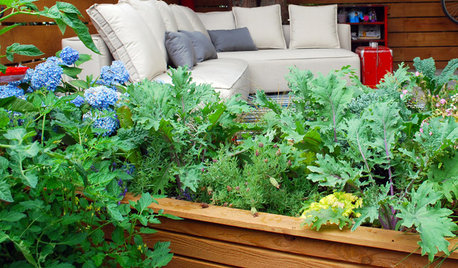new bin, bedding, drowning worms...
lpa405
15 years ago
Related Stories

GARDENING GUIDESHouzz TV: Make a Worm Bin for Rich Soil and Happy Plants
A worm-powered compost bin that can fit under a sink turns food scraps into a powerful amendment for your garden. Here’s how to make one
Full Story
GARDENING GUIDESNew Ways to Think About All That Mulch in the Garden
Before you go making a mountain out of a mulch hill, learn the facts about what your plants and soil really want
Full Story
GARDENING GUIDESGet on a Composting Kick (Hello, Free Fertilizer!)
Quit shelling out for pricey substitutes that aren’t even as good. Here’s how to give your soil the best while lightening your trash load
Full Story
GARDENING GUIDESStep Right Outside for Fresh Herbs and Vegetables
Decks and patios can be convenient spots for edibles, and sometimes they even offer advantages over backyard gardens
Full Story
GARDENING GUIDESPacific Northwest Gardener's November Checklist
Set a festive mood with a container garden while preserving and protecting your landscape and water features
Full Story
EDIBLE GARDENSHow to Grow Your Own Sweet Summer Crops
This guide will help any gardener get started on growing the freshest warm-season veggies and berries for summer
Full Story
FARM YOUR YARDHow to Grow Vegetables in Containers
Get glorious vegetables and fruits on your patio with a pro’s guidance — including his personal recipe for potting mix
Full Story
GARDENING GUIDESGarden Myths to Debunk as You Dig This Fall and Rest Over Winter
Termites hate wood mulch, don’t amend soil for trees, avoid gravel in planters — and more nuggets of garden wisdom
Full Story
MOST POPULARHow to Get Rid of Those Pesky Summer Fruit Flies
Learn what fruit flies are, how to prevent them and how to get rid of them in your home
Full Story
FALL GARDENING7 Reasons Not to Clean Up Your Fall Garden
Before you pluck and rake, consider wildlife, the health of your plants and your own right to relax
Full StoryMore Discussions






lpa405Original Author
anewgarden
Related Professionals
La Marque Landscape Architects & Landscape Designers · Bound Brook Landscape Contractors · Hoover Landscape Contractors · Lynwood Landscape Contractors · Miller Place Landscape Contractors · Mount Kisco Landscape Contractors · Red Oak Landscape Contractors · Riverview Landscape Contractors · Norco Stone, Pavers & Concrete · Jackson General Contractors · Monroe General Contractors · National City General Contractors · Olney General Contractors · San Bruno General Contractors · Villa Park General Contractorssbryce_gw
rredbbeard
lpa405Original Author
sbryce_gw